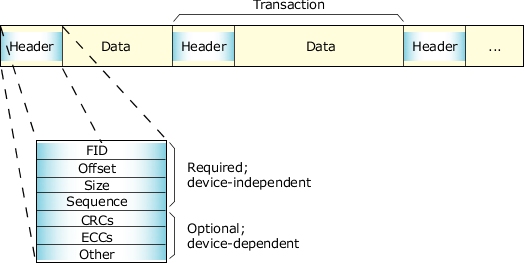ETFS implements a high-reliability filesystem for use with embedded solid-state memory devices, particularly NAND flash memory.
The filesystem supports a fully hierarchical directory structure with POSIX semantics as shown in the table above.
ETFS is a filesystem composed entirely of transactions. Every write operation, whether of user data or filesystem metadata, consists of a transaction. A transaction either succeeds or is treated as if it never occurred.
Transactions never overwrite live data. A write in the middle of a file or a directory update always writes to a new unused area. In this way, if the operation fails part way through (due to a crash or power failure), the old data is still intact.
Some log-based filesystems also operate under the principle that live data is never overwritten. But ETFS takes this to the extreme by turning everything into a log of transactions. The filesystem hierarchy is built on the fly by processing the log of transactions in the device. This scan occurs at startup, but is designed such that only a small subset of the data is read and CRC-checked, resulting in faster startup times without sacrificing reliability.
Transactions are position-independent in the device and may occur in any order. You could read the transactions from one device and write them in a different order to another device. This is important because it allows bulk programming of devices containing bad blocks that may be at arbitrary locations.
This design is well-suited for NAND flash memory. NAND flash is shipped with factory-marked bad blocks that may occur in any location.
 Figure 1. ETFS is a filesystem composed entirely of transactions.
Figure 1. ETFS is a filesystem composed entirely of transactions.